Fellow thinkers, the following essay is a mind stretcher. It may turn your concept of reality upside down. So you should pass on this one, if you are truly happy with our present world. –TW
… Instead of taking counsel of despair, I make bold to vary my statements, in the faint hope that repeated droppings may wear upon the stone, and that my formulas may seem less obscure if surrounded by something more of a ‘mass’ whereby to apperceive them.
William James,1909 The Meaning of Truth
Humanity is moving ever deeper into crisis – a crisis without precedent. First, it is a crisis brought about by cosmic evolution irrevocably intent upon completely transforming omnidisintegrated humanity from a complex of around-the-world, remotely-deployed-from-one-another, differently colored, differently credoed, differently cultured, differently communicating, and differently competing entities into a completely integrated, comprehensively interconsiderate, harmonious whole.
Second, we are in an unprecedented crisis because cosmic evolution is also irrevocably intent upon making omni-integrated humanity omnisuccessful, able to live sustainingly at an unprecedentedly higher standard of living for all Earthians than has ever been experienced by any; able to live entirely within its cosmic-energy income instead of spending its cosmic energy savings account (i.e., the fossil fuels) or spending its cosmic-capital plant and equipment account (i.e., atomic energy) – the atoms with which our Spaceship Earth and its biosphere are structured and equipped – a spending folly no less illogical than burning your house-and-home to keep the family warm on an unprecedentedly cold midwinter night.
Humanity’s cosmic-energy income account consists entirely of our gravity-and star (99 percent Sun) – distributed cosmic dividends of water power, tidal power, wave power, wind power, vegetation-produced alcohols, methane gas, vulcanism, and so on. Humanity’s present rate of total energy consumption amounts to only one four-millionth of one percent of the rate of its energy income.
…Ninety-nine percent of humanity does not know that we have the option to “make it” economically on this planet and in the Universe. We do.
Buckminster Fuller,1981 Critical Path
Man is always the measure of all things, even in matters of space and dimension.
Robert M. Pirsig,1992 Lila
Dan Glover
Pragmatism, Precession and the Metaphysics of Quality
What is truth? Is there only one, just ‘a’- Truth? Or are there many truths? b- truth and c- truth and d-truth and on and on, contained within One? Is such a thing even possible? The concept of “many truths” presupposes One truth by the virtue of talking about truth at all, as well as supposing definition of a truth as an independently existing reality in the universe, doesn’t it?
In this paper I would like to explore the meaning of truth, whether it is indeed a verifiable independent reality in the universe, or if it is only what we agree it is. I will be quoting mainly from these sources: the works of Robert M. Pirsig, including Lila; An Inquiry Into Morals, and Zen and the Art of Motorcycle Maintenance; An Inquiry into Values , The Meaning of Truth, Pragmatism, and Essays in Radical Empiricism by William James, who Pirsig makes mention of in Lila, and Critical Path by R. Buckminster Fuller, since his work helps to explain some of the irrelevant meanings that Pirsig talks about in Lila.
James describes reality in the much the same terms as Carlos Castaneda. In a previous paper, Quality is a Good Dog I explored the complex relationship between the Metaphysics of Quality as proposed by Robert M. Pirsig and the writings of Castaneda, the teachings of don Juan Matus, a Yaqui Indian from Sonora. I will assume the reader is familiar with it here. And in another paper called Force of Value in the Metaphysics of Quality I explored in a small way the complex relationship between the social and intellect levels of Pirsig’s theory as depicted in his diagram from his Subjects, Objects, Data and Values paper.
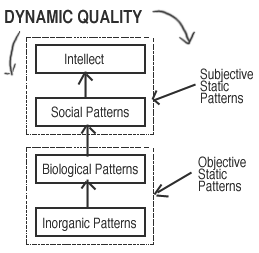 In order to use this diagram, it must be realized it is a pragmatic tool, a metaphor and not an actual map of reality. To understand pragmatism, its worthwhile exploring the thinking behind it briefly.
In order to use this diagram, it must be realized it is a pragmatic tool, a metaphor and not an actual map of reality. To understand pragmatism, its worthwhile exploring the thinking behind it briefly.
Taking Pragmatism down from the shelf, we read William James writing in 1907: … I wish to illustrate the pragmatic method by one more application. I wish to turn its light upon the ancient problem of ‘the one and the many’. I suspect that in but a few of you this problem occasioned sleepless nights, and I should not be astonished if some of you told me that it had never vexed you. I myself have come, by long brooding over it, to consider it the most central of all philosophic problems, central because so pregnant. I mean by this that if you know whether a man is a decided monist or a decided pluralist, you perhaps know more about the rest of his opinions than if you give him any other name ending in ist. To believe in the one or in the many, that is the classification with the maximum number of consequences.Pragmatism page 50
[We] treat the problem of the One and the Many in a purely intellectual way; and we see clearly enough where pragmatism stands. With her criterion of the practical differences that theories make, we see she must equally abjure absolute monism and absolute pluralism. The world is one just so far as its parts hang together by any definite connexion. It is many just so far as any definite connexion fails to obtain. And finally it is growing more and more unified by those systems of connexion at least which human energy keeps framing as time goes on. Pragmatism page 60
Pragmatism relies on “common-sense” everyday reality to lend agreement to its conclusions. Lets start by examining just what James means by pragmatism. In The Meaning of Truth he writes: My account of truth is realistic, and follows the epistemological dualism of common sense. Suppose I say to you ‘The thing exists’ – is that true or not? How can you tell? Not till any statement has developed its meaning farther is it determined as being true, false or irrelevant to reality altogether. But if now you ask ‘what thing?’ and I reply ‘a desk’; if you ask ‘where?’ and I point to a place; if you ask ‘does it exist materially, or only in imagination?’ and I say ‘materially’; if moreover I say ‘I mean that desk,’ and then grasp and shake a desk which you see just as I have described it, you are willing to call my statement true. But you and I are commutable here; we can exchange places; and as you go bail for my desk, so I can go bail for yours. The Meaning of Truth
This notion of commutability is an underpinning of pragmatism. Basically, our reality consists of observations only the individual can be sure of. But because of commutability, we are able to assume a concrete reality independent of the self by assuming others with like quality’s to our self also view this independent reality in the very same way as we our self. Subjects and objects are born by agreement with commutability. James goes on:
This notion of a reality independent of either of us, taken from ordinary social experience, lies at the base of the pragmatic definition of truth. With some such reality any statement, in order to be counted true, must agree. Pragmatism defines ‘agreeing’ to mean certain ways of ‘working’, be they actual or potential. Thus, for my statement ‘the desk exists’ to be true of a desk recognized as real by you, it must be able to lead me to shake your desk, to explain to myself by words that suggest that desk to your mind, to make a drawing that is like the desk you see, etc. The Meaning of Truth
Here James gives us the essence of his pragmatism. It is essential to note he uses “ordinary social experiences” as the basis for pragmatic truth. Cultural realism. In order for something to be counted true, we MUST recognize an independent reality beyond “our self” AND AGREE WITH OTHERS THROUGH ORDINARY SOCIAL EXPERIENCE. We see James is starting with social experience “agreements” to develop his pragmatism. This is his foundation, much as don Juan’s tonal is the foundation of his teachings and Pirsig’s foundation of static quality everyday reality comprising everything that arises from awareness.
James continues: Only in such ways as this is there sense in saying it agrees with that reality, only thus does it gain for me the satisfaction of hearing you corroborate me. Reference then to something determinate, and some sort of adaptation to it worthy of the name of agreement, are thus constituent elements in the definition of any statement of mine as ‘true’. The Meaning of Truth (remarks at the meeting of the American Philosophical Association, Cornell University, December, 1907)
Reference is to something determinate. For that something to be determinate, we must all agree that it is indeed a determinate something. James calls that determinate something “social experience”. Looking at this from a Metaphysics of Quality point of view, social experience can be seen as a social level pattern of value opposed to both a higher level intellect pattern of value and a lower biological level. Unlike the Metaphysics of Quality, pragmatism seems to assume the existence of the molecules that make up social experience as well as the biological life forms and starts with the social level as a basis.
James writes: “Pragmatism defines ‘agreeing’ to mean certain ways of ‘working’, be they actual or potential.” “Agreeing” is a difficult term to define. I find I use it in my own writings and I have attempted to define it in the past when asked, but have always failed to really convey what I meant. I am somewhat at a loss to understand James definition too. I wonder why Pirsig felt highly enough of James to mention him in Lila? Here is what Pirsig wrote:
However, in his rereading of [William] James, he had so far found three things that were beginning to dissolve his early prejudice. The first wasn’t really a reason, but was such an unlikely coincidence Phædrus couldn’t get it out of his mind. James was the godfather of William James Sidis, the child prodigy who could speak five languages at the age of five and who thought colonial democracy came from the Indians. The second was a reference to James’s dislike of the dichotomy of the universe into subjects and objects. But the third thing, which might also seem irrelevant, but which was doing more than anything else to dissolve Phædrus’s early prejudice, was an anecdote James told about a squirrel.
James and a group of friends were on an outing somewhere and one of them chased a squirrel around a tree. The squirrel instinctively clung to the opposite side of the tree and moved so that as the man circled the tree the squirrel also circled it on the opposite side.
After observing this, James and his friends engaged in a philosophic discussion of the question: Did the man go around the squirrel or didn’t he? The group broke into two philosophical camps and Phædrus didn’t remember how the argument was resolved. What impressed him was James interest in the question. It showed that although James was no doubt an expert philosophologist (certainly he had to be to teach stuff at Harvard) he was also a philosopher in the creative sense. A philosophologist would have been mildly contemptuous of such a discussion because it had no “importance”, that is, no body of philosophical writings existed about it. But to a creative philosopher like James the question was like catnip. Lila page 373-4 Being a creative philosopher, James point of view evolved into what he called Radical Empiricism, distinct in his opinion from pragmatism. In his Essays in Radical Empiricism he writes: Although for fluency’s sake I myself spoke early in this article of a stuff of pure experience, I have now to say there is no general stuff of which experience at large is made of. There are as many stuffs as there are ‘natures’ in the things experienced. If you ask what any one bit of pure experience is, the answer is always the same: “It is made of that, of just what appears, of space, of intensity, of flatness, brownness, heaviness or what not.” Experience is only a collective name for all these sensible natures, and save for time and space (and, if you like, for “being”) there appears no universal element of which all are made. Essays in Radical Empiricism, Does Consciousness Exist? Page 27-8
Here James makes no bones about his methods. He says that what we perceive is just that, just what it appears to be and nothing more or less. James’ conclusions are much the same as Pirsig’s answer to the mind/matter platypus, that all schools of thought are right on the subject. The “rightness” is built on a foundation of agreements with reality that we have each formed prior to the experience.
James builds this line of thought into “perceptual experiences” and “conceptual experiences”. He writes: Of [these], our perceptual experiences are the nucleus, they being the originally strong experiences. We add conceptual experiences to them, making these strong also in imagination, and building out the remoter parts of the physical world by their means; and around this core of reality the world of laxly connected fancies and mere rhapsodical objects floats like a bank of clouds. In the clouds, all sorts of rules are violated which in the core are kept. Extensions there can be indefinitely located; motion there obeys no Newton’s laws. Essays in Radical Empiricism, Page 34
This sounds remarkably like Robert Pirsig’s Dynamic Quality that James is attempting to describe here. I am intrigued by seemingly inconsequential, irrelevant coincidences, like Pirsig is, and he mentions in Lila that William James was the godfather of William James Sidis. I have also read off-handedly about Buckminster Fuller being given a copy of one of William James Sidis’ books and being very impressed with the depth of understanding portrayed by Sidis.
Buckminster Fuller (sometimes described as an eccentric genius, though he himself was loath to call himself a genius of any kind) was also impressed with seemingly inconsequential happenings, so much so that he declared those coincidences and seeming irrelevant happenings as the “real” way the universe operates, and named that action “precession”.
Precession explains these seemingly irrelevant happenings and coincidences beautifully, and is perhaps the way Dynamic Quality operates in the universe, so perhaps it’s worthwhile looking into a a bit more detail. Of course this will take us a bit off-track, but perhaps we will get to where we are going anyway. In his book Critical Path Fuller explains what precession is and why it is the fundamental way the universe operates.
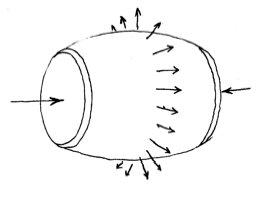
When we push toward one another the opposite rigid-disc ends of a flexible, water-filled cylinder, the center swells maximally outward in a circular plane perpendicular (at right angles) to the line of our pushing together.
When we pull away from one another on the opposite ends of the same water-filled cylinder, the middle part contracts in a concentric series of circular planes of diminishing radius perpendicular (at right angles) to the line of our pulling.
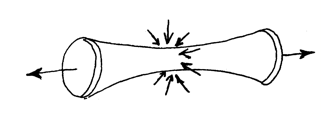
When we drop a stone in the water, a circular wave is generated that moves outwardly in a plane perpendicular (at right angles) to the line of stone-dropping – the outwardly expanding circular wave generates (at ninety degrees) a vertical wave that in turn generates an additional horizontally and outwardly expanding wave, and so on.
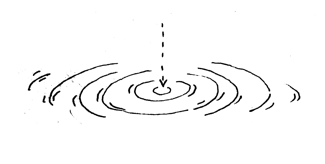
All these right-angle effects are precessional effects. Precession is the effect of bodies in motion on other bodies in motion.
The sun and the earth are both in motion. Despite the 180 degree gravitational pull of the in-motion sun upon the in-motion earth, precession makes earth orbit around the sun in a direction that is at ninety degrees – i.e., at right angles – to the direction of the sun’s pull upon earth.
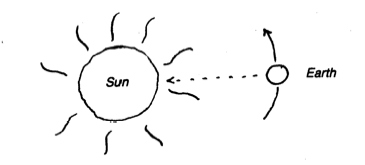
The successful regeneration of life growth on our planet Earth is ecologically accomplished always and only as the precessional, right-angled “side-effect” of the biological species’ chromosomically programmed individual-survival preoccupation’s – the honeybees are chromosomically programed to enter the flower blossoms in search of honey. Seemingly inadvertently (but realistically precessionally) this occasions the bee’s bumbling tail’s becoming dusted with pollen (at ninety degrees to each bees’ linear axis and flight path), where after the bees’ further bumbling entries into other flowers at right angles inadvertently dusts off, pollenizes, and cross-fertilizes those flowers at right-angles (precessionally) to the bees’ operating axis – so too, do all the mobile creatures of Earth cross-fertilize all the different rooted botanicals in one fashion or another precessionally (right-angled), inadvertent way. Critical Path Page 141-2
There are no solids. There are no things. There are only interfering and non interfering patterns operative in pure principle, and principles are eternal. Principles never contradict principles. Principles can interaccomodate one another only in non interfering frequency ways. Principles can interaugment one another if frequency is synchronizable. Critical Path Page 158
Here we have a description of reality that is very close to Pirsig’s Metaphysics of Quality’s description of static quality and Dynamic Quality and what William James calls pragmatism. All three deny the dichotomy of subject/object thinking as a foundational base and instead incorporate an actuality/potentiality, interfering/non interfering patterns operative in pure principle state, a static quality/Dynamic Quality division as a fundamental basis as a metaphor of reality.
This concept is of primary importance to understanding the Metaphysics of Quality and the interactions of the four static levels with Dynamic Quality via the forces of value creating and discreating our everyday reality in a precessional way. Even though Pirsig uses the term “division of reality” in describing static quality/ Dynamic Quality, that is not really a proper way of talking about this “split”.
This is what James calls a determinate social experience. We all “know” how to split something…we do it all the time. But the division Pirsig talks about is beyond our conception of the four static levels of reality, beyond our awareness altogether. We have all formed “agreements” with each other through social interactions from the time we were born. These agreements are all we know, and all we can ever know. But if this is true, where do new agreements arise? How can we ever learn anything new? Clearly we must “know” much more than we think we know at any moment in time.
Interacting then, in a precessional, or right-angled manner, is the fundamental way the entire universe operates. Recognizing this, we can then say that this is how the four static levels of the Metaphysics of Quality also interact with one another.
From Zen and the Art of Motorcycle Maintenance we read: In all of the Oriental religions great value is placed on the Sanskrit doctrine of Tat rvam asi, “Thou art that,” which asserts that everything you think you are and everything you think you perceive are undivided. To realize fully this lack of division is to become enlightened.
Logic presumes a separation of subject from object; therefore logic is not final wisdom. The illusion of separation of subject from object is best removed by the elimination of physical activity, mental activity and emotional activity. (Page 126, paperback)
This separation of subject and object is also a focus of James when he writes: …the pragmatic method, in its dealings with certain concepts, instead of ending up with admiring contemplation, plunges forward into the river of experience with them and prolongs the perspective by their means. Design, free-will, the absolute mind, spirit instead of matter, have for their sole meaning a better promise as to this world’s outcome. Be they false or be they true, the meaning of them is this meliorism.
I have sometimes thought of the phenomenon called ‘total reflexion’ in optics as a good symbol of the relation between abstract ideas and concrete realities, as pragmatism conceives it. Hold a tumbler of water a little above your eyes and look up through the water at its surface – or better still look similarly through the flat wall of an aquarium. You will then see an extraordinary brilliant reflected image say of a candle-flame, or any other clear object, situated on the opposite side of the vessel. No candle ray, under these circumstances, gets beyond the water’s surface: every ray is totally reflected back into the depths again. (Pragmatism page 128, The One and the Many)
This is how I like to look at the relationship between the social and intellect levels in the Metaphysics of Quality. Logic arises as social level agreements to what is normally perceived as an independently existing reality, commutable between us as individuals. This commutability arises Dynamically in a precessional manner permeating the four static levels of everyday static quality patterns of value with forces of value. These forces direct the social level to create our entire reality, while at the same time they direct the intellect level patterns of value to seek Dynamic freedom precessionally from the underlying social level by means of abstraction, or discreation of what would otherwise be exclusively permanent stasis and stagnation in the social level.
In conclusion then, what is Truth? Pragmatically, Truth is an agreement, and as such, it is a social level pattern of value within the Metaphysics of Quality. Precessionally, Truth always occurs at a right angled intersection of the Quality Event (interesting connections to Pirsig’s explorations of the morpheme rt where he writes “The right-handedness was also interesting”, Page 434 Lila). Truth lies in value forces that direct the four levels of static quality patterns of value in the Metaphysics of Quality. Hopefully this paper sheds just a little more light on how these forces of value operate in the universe.